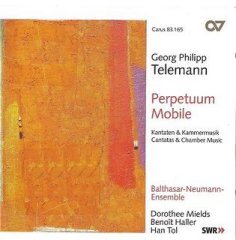Georg Philipp Telemann – Perpetuum Mobile (2000)
Georg Philipp Telemann – Perpetuum Mobile (2000)

Kantate TWV 1-795 - Hier Ist Mein Herz, Geliebter Jesu Quartett TWV 43:g4 Passionkantate TWV 1-1536 - Weiche, Lust Und Frohlichkeit Quartett TWV 43:a3 Psalm 6 TWV 7-2 - Ach Herr, Strafe Mich Nicht Ouverture TWV 55:D12 Dorothee Mields, soprano Benoit Haller, tenor Han Tol, recorder & direction Balthasar-Neumann-Ensemble
Believe it or not, and I must speak in a hushed whisper, there are folk out there, and I sometimes think that I am one, who prefer Telemann to the great J.S. Bach. Why? Because he is more fun, more eclectic and a little more human although it has to be added that generally he is considered somewhat less profound. Having heard this CD a few times I am rather inclined to that view myself.
The CD gets its title from the second movement of the ‘Ouverture in D’ - a seventeen minute seven movement suite mostly consisting of the usual Sarabande, Bourée, Gigue etc movements. Amongst the usual suspects appears this singular ‘Perpetuum mobile’ which, at just a minute and a half, makes its point and is gone. It is a rare feature of such a suite and raises a gentle smile. But then other pieces on this gloriously performed recording do exactly the same.
As a chamber music composer Telemann is ‘spot-on’, good fun for both listeners and instrumentalists. So the planning of this CD offers us the best of both worlds, mixing, as it does, three twelve minute cantatas, all unpublished, and three instrumental works.
The first piece on the CD is for the feast of the Epiphany. Like all of the cantatas featured here it is a world premiere recording. It is scored for soprano and tenor and its opening duet, which I have played now quite often, with its wonderful suspensions in the words ‘Here is my heart, beloved Jesus’, immediately dispels the idea that Telemann cannot plumb the depths. A similarly moving opening can be heard in the cantata ‘Ac herr, strafe ich’, a setting for solo tenor and instruments of Psalm 6 beginning ‘O Lord punish me not in thy anger’. Here again dissonances and a falling suspension create a very moving atmosphere. The mood gradually lightens for the final ‘For all my foes shall be turned back and confounded’.
The middle cantata on the disc makes a nice contrast being scored for just solo soprano and ensemble. It sets a somewhat sober Passiontide text ‘Desist, pleasure and merriment’ (‘Weiche, Lust und Frohlichkeit’). These cantatas are divided into opening and closing arias with linked recitatives and/or ariosos with quite often have virtuoso instrumental work embedded somewhere in them - often for no special reason. In this latter cantata the violin writing in the middle aria ‘To redeem us accursed mortals’ is just like this, as is the writing for oboes in the tenor cantata also in the middle aria. The vocal writing is often incredibly challenging. The wonderful soprano Dorothee Mields is quoted in Doris Blaich’s excellent booklet notes as saying "How did these early singers manage to sing such long coloratura without breathing?". Quite so. Amazing to contemplate therefore that there are some 1700 cantatas like this awaiting a completist recording project! Telemann, it must be remembered, is really a church music composer, just like Bach.
The purely instrumental works would have been considered to be less typical of the composer by his contemporaries but it is this aspect of his work that we are nowadays more familiar with. Again it is often the flair and excitement of the writing which attracts. The A minor quartet for recorder, oboe, violin and continuo is a good example. It is in four movements beginning with an Adagio. I defy anyone who hears it not to be lulled by its smooth antiphonal writing. The ensuing Allegro is fugal with an independent and busy bass line. The following Adagio is elegant and conversational between the violin and oboe and recorder running together. The final Vivace leads off with a serious fugal idea on the oboe which takes on a life of its own before being answered by a recorder passage of much virtuosity. When the violin joins in it does so rather secretly before taking up the tune and becoming an equal partner particularly after a flashy virtuoso passage of its own. This busy movement is the longest by some way and brings the work to a highly successful conclusion. The three movement Quartet in G minor is scored for violin, viola and continuo and is less distinctive although its final Allegro is quite exciting.
So, to sum up. This is a very enjoyable if possibly slightly esoteric disc of energising and fulfilling music by a man who seems to have described himself as a "workaholic" and who "could not bear idleness" (according to the publicity with the disc). The performances by this outstanding ensemble match the composer’s inspiration and sometimes even exceed it. I recommend it to all readers of any persuasion. ---Gary Higginson, musicweb-international.com
download: uploaded yandex 4shared mediafire solidfiles mega zalivalka filecloudio anonfiles oboom
Last Updated (Friday, 06 June 2014 16:00)








